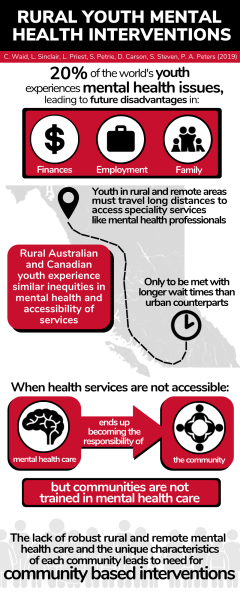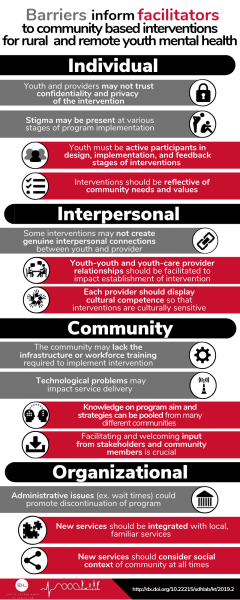Infographic – Physician Recruitment and Retention
Sendanyoye C, Petrie S, Carson DB, Stevens S, & PA Peters. (2019) Infographic: Recruitment and Retention of Rural Physicians. Spatial Determinants of Health Lab, Carleton University: Ottawa, ON. DOI:10.22215/sdhlab/kt/2019.1
A high-quality PDF of this infographic is available for download.
Rural and remote communities contribute around 32% and 22% to Australia’s and Canada’s population, respectively. However, only 14% and 16% of family physicians in Australia and Canada, respectively, practice in these communities, resulting in an obvious disproportion in access as compared with urban areas. An erosion of health services occurs when the number of physicians, and other health care providers, in a region is insufficient or these professionals are non-existent. Inaccessibility to services in rural and remote communities results in poor health outcomes for all involved.

Strategies in Australia and Canada have been implemented to address high rural physician turnover rates and lessening interest in entering rural practice. These strategies have focused on supporting recruitment and retention initiatives to first bring physicians into rural practice and then encourage physicians to continue in rural practice beyond the short-term.
These programs have so far been insufficient or ineffective to address the lack of physicians in rural and remote areas. A review of recent literature related to recruitment and retention initiatives focused on rural physicians in Australia and Canada was conducted to better investigate the strengths and limitations of various initiatives. Further, this review critically examines the short and long-term feasibility of certain initiatives to develop a conceptual framework for designing or examining initiatives focused on rural physicians.
We have created an infographic about recruitment and retention initiatives that we reviewed from the literature. Our hope is that this summary can provide a starting point for programs, policies, and research that seeks to increase and stabilize the availability of physicians in rural and remote communities.

